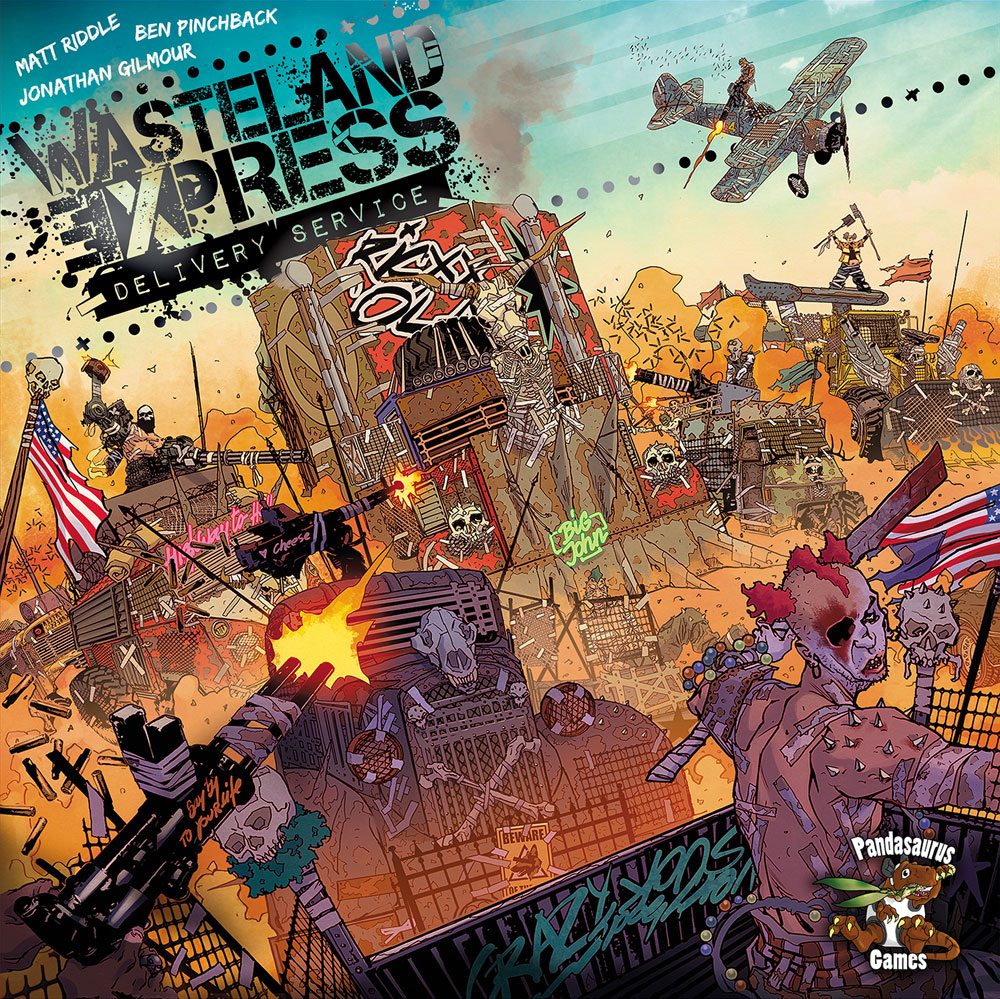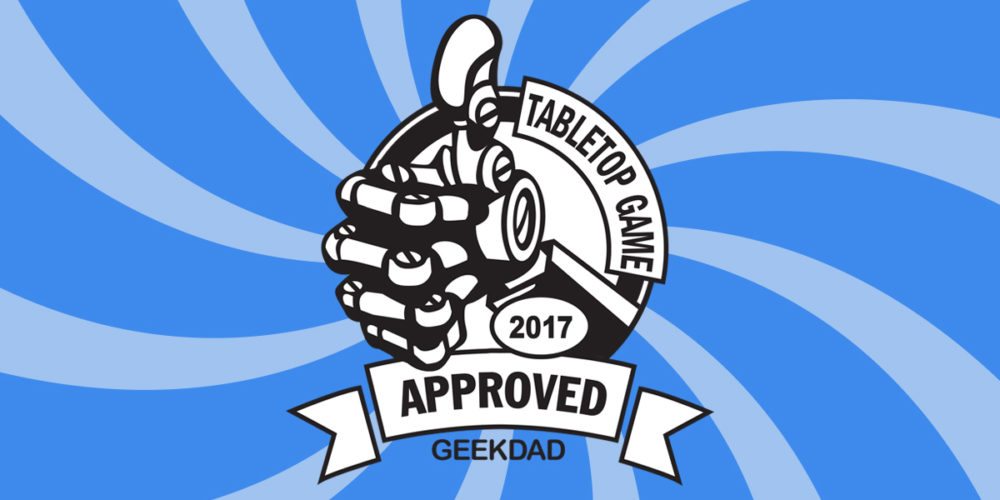In this post-apocalyptic world, there’s only one real job to be had: truck driver. As an employee of the Wasteland Express Delivery Service, you’ll drive between outposts, delivering food, water, and guns to make a little scrap for yourself. The bad news: to make the drop, you’ll have to get past raiders and irradiated zones.
What Is Wasteland Express Delivery Service?
Wasteland Express Delivery Service is a pick-up-and-deliver game for 2 to 5 players, ages 13 and up, and takes 90–120 minutes to play. It’s available in game stores and online now (from Amazon and direct from Pandasaurus, among others), with a retail price of $79.95. The theme has a Mad Max vibe to it and the artwork includes some crazy post-apocalyptic characters, so you may want to preview it before playing with kids; the gameplay is medium-to-heavy and so it’s not one for kids who are new to games.
Wasteland Express Delivery Service is GeekDad Approved!

Wasteland Express Delivery Service Components
- 10 Truck Miniatures (6 player trucks, 3 raider trucks, 1 Grand Lord Emperor Torque)
- 75 Cargo Goods (25 each Food, Water, Guns)
- 10 Combat dice
- Radiation Check die
- Raider Check die
- 16 Terrain tiles
- 21 Location tiles (4 raider enclaves, 17 outposts)
- 25 Action Markers (5 per player)
- 6 Player boards
- 18 Character standees (3 per character)
- 6 “Not Welcome” standees (1 per character)
- 60 Progress Marker tokens (10 per character)
- 1 Mod Shop board
- 1 Market board
- Cardboard Tokens:
- 5 Nuclear Bomb tokens
- 22 Supply tokens
- 36 Demand tokens
- 40 Damage tokens
- 10 Trailer tokens
- 20 Artifact tokens
- 15 Dig tokens
- 125 Truck Mod tokens:
- 15 General Storage
- 15 Weapons Storage
- 10 Gunners
- 10 Sleeper Cabs
- 10 Machine Guns
- 10 Turbos
- 5 Nuclear Vaults
- 5 Brokers
- 5 Diggers
- 5 Radiation Shields
- 5 Armor
- 10 Escorts
- 10 Missiles
- 10 Bonuses
- 105 Scrap tokens:
- 60 $1
- 30 $5
- 15 $10
- Cards:
- 16 Ally cards
- 9 Raider Truck cards
- 16 Raider Enclave cards
- 10 Event cards
- 15 Vision Quest cards
- 8 Priority First-Class Contract cards
- 45 Faction Job cards (15 each in 3 factions)
- GameTrayz custom inserts
So, the first thing to notice is that this game has a truckload of components. The box itself is a large square, twice as tall as most game boxes, and when you first get it it’s filled with cardboard to punch out, so if you love punching cardboard, that’s worth the price right there.

The game looks great—the interface and graphics give everything a low-tech slapped-together look, with hand-drawn arrows and lettering. The trailer tokens look like they were drawn with a felt-tip marker on a sticky note, and the scrap (currency) looks like washers of various sizes with numbers chalked onto them.

The illustrations for the raiders and player characters are more of a comic book style and are pretty over-the-top. After the apocalypse, spikes and chains and fishnet are in, of course, and you’ll find some pretty crazy costumes. The vehicles are all armored up and covered with spikes and so on. Grand Lord Emperor Torque is basically a centaur only with a car instead of a horse for his bottom half. I’m not exactly sure how that works, but just go with it.
The terrain tiles have a top-down look at a burnt-out wasteland.
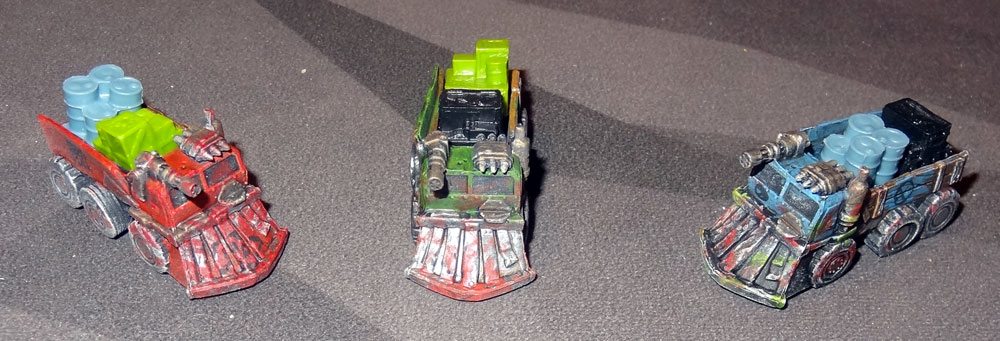
The miniatures start off as grey plastic and they’re pretty detailed. The three raider trucks are identical, and small stickers are provided for each side so that you can tell them apart—they’re red, green, and blue (corresponding to three of the raider factions). My friend Tiffany (TheOneTAR) Caires, who borrowed my copy to live-stream, felt that the trucks looked too similar, so she asked if I would mind if she painted them. Of course not! So now I have a really amazing looking set, and you can see her process in this YouTube video. The only complaint, if it bothers you, is that the vehicles aren’t to any sort of scale when compared to each other—the sizing is very weird. Mostly it’s so each vehicle is about the same overall length.
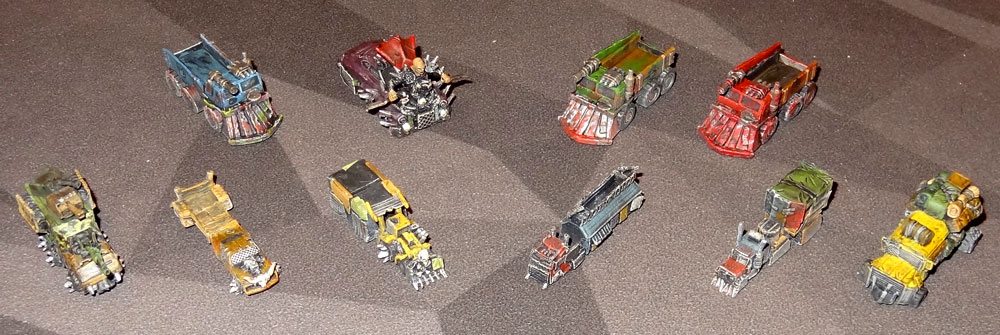
Your set will come in plain grey plastic, of course, but if you’re jealous of my painted set, you should subscribe to Tiffany’s YouTube channel. She’s planning to paint another set and run a giveaway in the near future!
The action markers are small plastic gears that are used to track your various actions on your player board. The cargo tokens (food, water, guns) are also molded plastic bits—stacks of green crates, blue barrels, and black ammo cases, sized so that two of them fit in the back of each raider truck. I asked Tiffany if she wanted to paint all of those, too, but she politely declined.
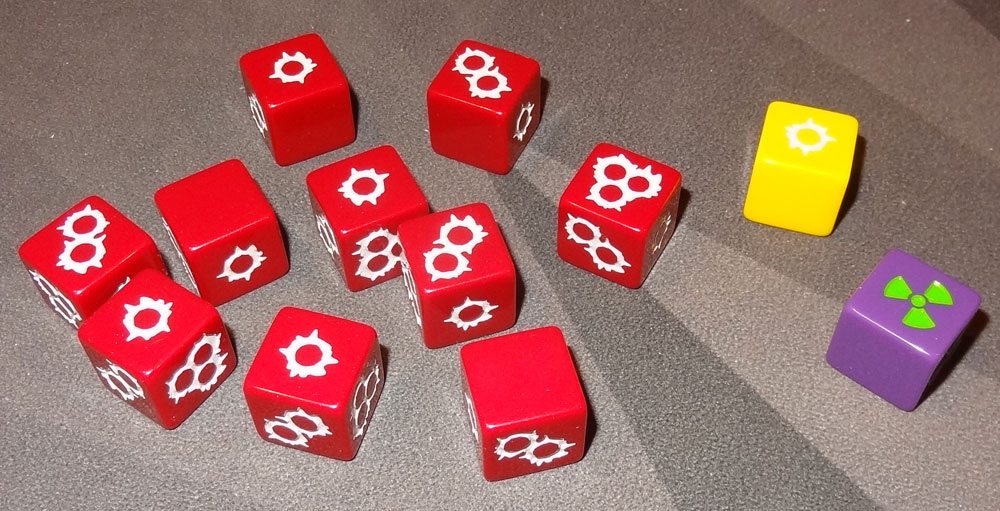
The dice are all custom six-sided dice, engraved and painted, and about standard size. The combat dice are red, with white “blast” icons on them. The radiation check die is purple with a green radiation symbol on some faces, and the raider check die is yellow with some blast icons on it. The white-on-yellow icon is a little harder to read than the others, but not terrible.
The character standees show the various character portraits, and match the head shot shown on the corresponding character board. They’re used for marking when you’ve completed a contract. The “not welcome” standees are the same illustration, but in black and white and with a large red X across it, and are used to mark the last place you made a delivery. My only complaint about these is that because they’re fairly large, it’s hard to fit more than one of them on the same location tile without obscuring the location tile itself.
Many of the cards—the events, contracts, and faction jobs—have flavor text on them that really adds to the theme of the game. In the rulebook, you’ll also find an introduction to set the scene, as well as background stories about the factions, the drivers, and a few other characters.
Okay, and finally we come to one of my favorite components in Wasteland Express: the box insert. Really.

The trays were made by Noah Adelman of GameTrayz and they’re a thing of wonder. We’ve gushed about them before, and we’ll continue gushing about them as long as he keeps making them. What’s fantastic is that these trays are actually included in the game—you don’t have to buy them separately. The Mod Shop has its own tray that holds all of the various truck upgrades—this tray has a cardboard face to it that enhances the theme. The resource tray is set up so that scrap is accessible on both ends of the tray.
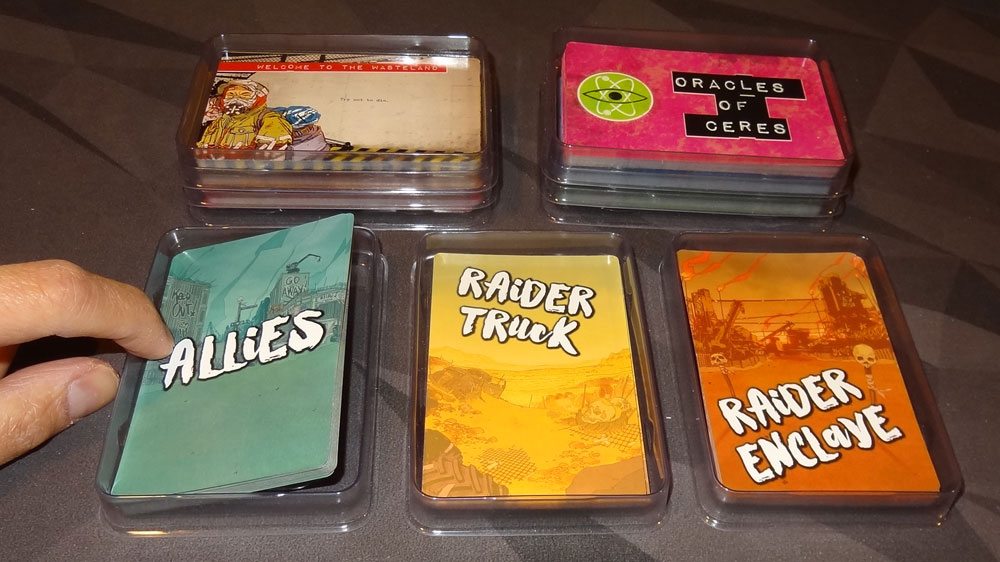
Each card deck has its own tray, and the trays stack easily. They have the push-and-tilt access so that you don’t have to dump the deck out or try to fit your fingers along the edge; you just push down on any edge and the whole deck pops up on the other side. Everything has a place, and the trays make setup much quicker because you just pull the tray off and take off the lid for all of those cardboard tokens, without having to sort them out into stacks on the table.

And when you put everything away, the trays stack and nest in such a way that nothing will shift around, and you don’t have to worry about opening up your game box only to find that everything’s a mess.
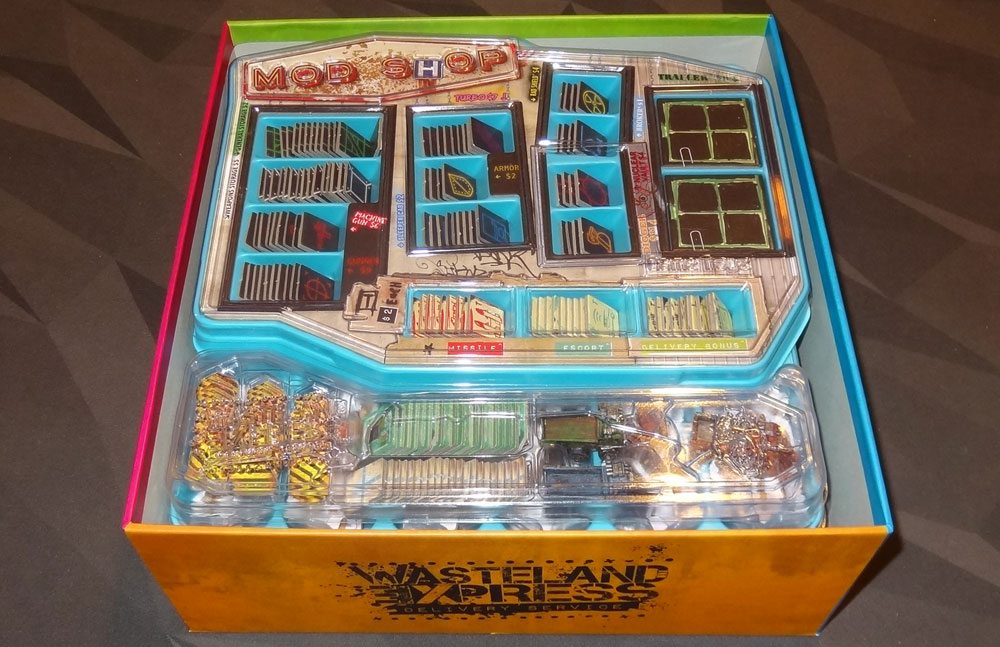
My only small complaint is this: after you punch everything out, you’re supposed to put about 10 sheets of cardboard into the bottom of the box, underneath the bottom tray (which holds the terrain tiles, among other things). That raises the whole stack up so the trays will be flush with the top of the box, so that means there’s actually some empty space at the bottom, and the box is really a little taller than it needs to be for the actual game. I wish more publishers would use the method where the box lid isn’t flush to the bottom before you punch out all the cardboard, but then afterward the lid closes flush and there’s no wasted space. Maybe next time.
How to Play Wasteland Express Delivery Service
The rulebook is available for download here.
The Goal
The goal of the game is to be the first to complete 3 First-Class Priority Contracts.
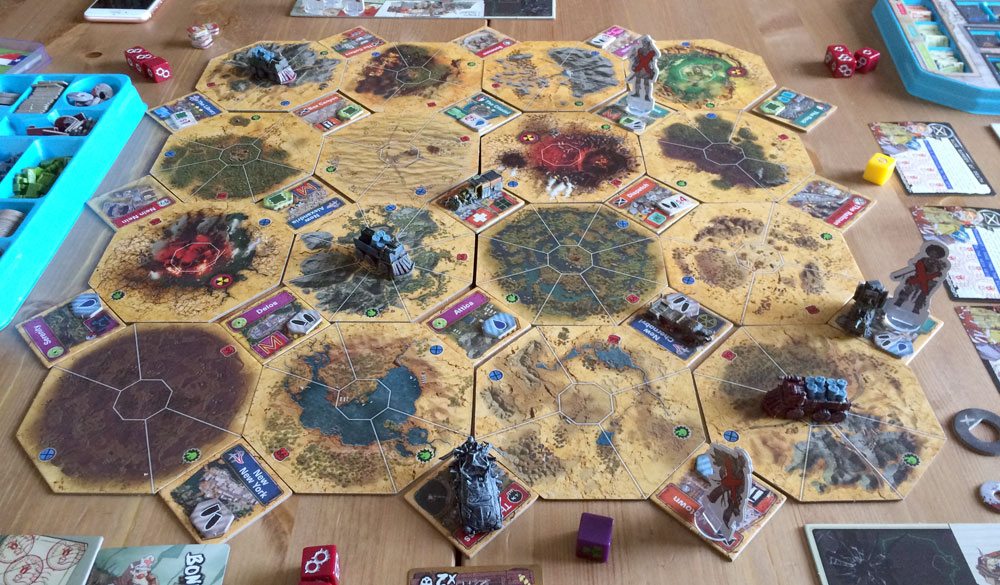
Setup
Lay out the octagonal terrain tiles in a 4×4 grid. The four raider enclaves go in the center spaces along the edges (with the Railmen and Nein Nein opposite each other), and the Depot in the very center. All the other location tiles are shuffled and distributed in the rest of the spaces. The three raider trucks start in three different corners—raider trucks are placed in the center of an octagon. Draw three raider truck cards to determine what cargo goes in the back of each of the three raider trucks.
Place the “Blue Screen of Death” and two more randomly drawn priority first-class contracts on the table, and put the rest away. Shuffle the events deck and put “Welcome to the Wasteland” face-up on the top of the deck.
Draw enough supply and demand tokens to fill in the locations with spaces for them. Make sure only to use demand tokens that have one resource, not two, for the initial setup. Put one food, one water, and one guns token on the market board price wheel at their starting locations. Then, for each demand token on the board, increase the price of that cargo. Place the artifacts on the market board, one per space, leaving the “$7” space uncovered, and place the extras in a stack at the very end.
Each player gets 5 action markers and a player board along with the matching truck, standees, and progress markers. Your three standees go on the ID card on your board, and the “not welcome” is set to the side. Each player also gets $10 in scrap, 2 cargo holds (1 general, 1 weapon) placed on their truck diagram, and any unique character bonuses shown on their board. Each player draws 1 card from each of the faction job decks, chooses one to keep, and places the others at the bottom of their decks. The trucks all start at the Depot.
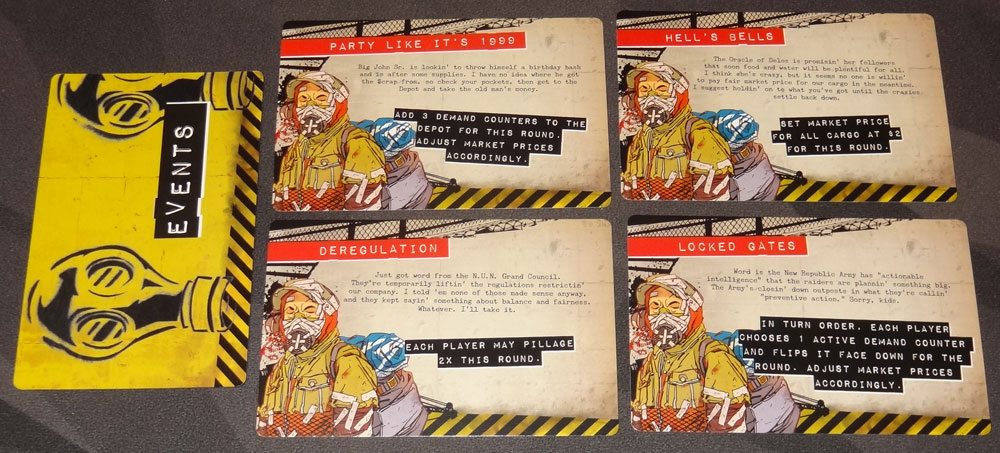
Gameplay
The start player takes the event deck, which also serves as the first player marker. The first event of the game is “Welcome to the Wasteland” and only has the flavor text “Try not to die.” On subsequent rounds, you’ll pass the event deck, and the new first player will draw the next event card and read it.
On each turn, you will take one of your action markers from the “Available” space and move it to your desired action, and then it’s the next player’s turn. After each player has taken five turns, the round ends.
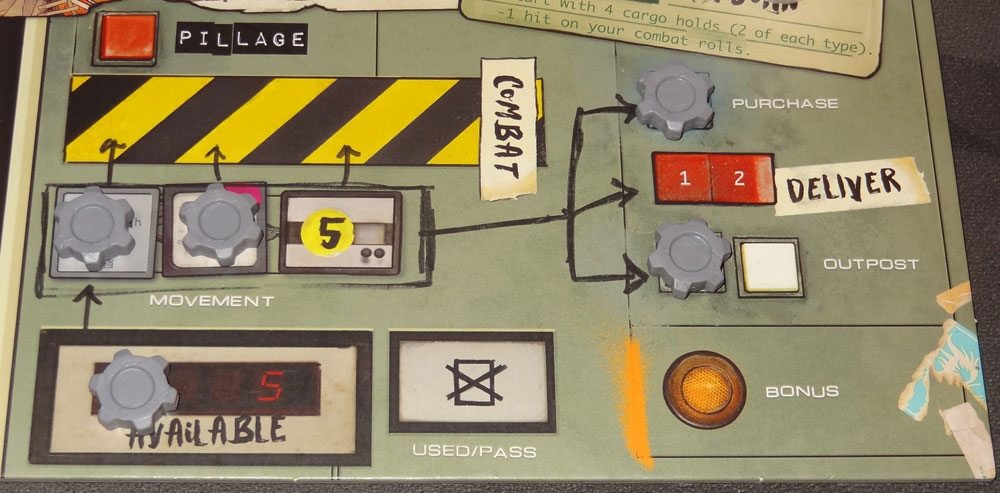
When you take your turn, you may move your truck, and then “slide” the action marker to another space along the arrows marked on the board. For instance, after moving, you can attack raiders, purchase cargo, deliver cargo, or activate an outpost. (You may also do these actions without moving if you are already in position.) There’s also a “bonus” action that you can take, but not after movement—there is no arrow connecting the movement actions to the bonus action. The number of times you can perform any particular action in one round is indicated by the number of spaces available.
Movement
To move, you slide your action marker to the lowest available movement space. The first one is 3, then 4, then 5—because if you don’t stop your truck to take an action, you build up momentum and can move further. If you ever stop to do an action and slide your action marker to the action space, any previous movement markers are moved to the “used” section because you lose your momentum. There are spaces marked on the terrain tiles—each space is one movement, and you may also move onto and through the square location tiles. You may not move onto the center of each octagon—that’s reserved for the raiders.
If you move through an irradiated zone (marked with the radiation icon), you must roll the purple die and see if you take damage, unless you own a radiation shield. If you move onto a tile with a raider truck, you must either stop immediately for combat, or keep driving but roll the yellow die to see if you get hit as you drive by.
If you end your turn on a terrain space that shows one of the raider faction symbols, you move the corresponding raider truck one terrain tile in any direction, leapfrogging over other raider trucks if applicable. Any players in that space are immediately ambushed and may take damage.
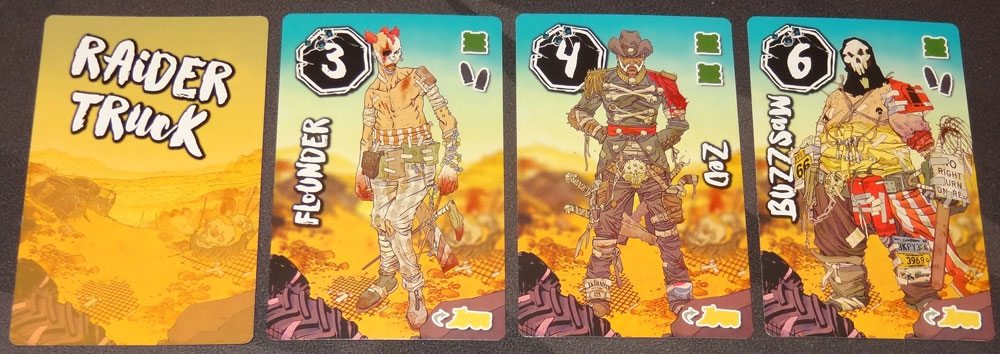
Combat
Slide your action marker to Combat. You can attack raiders, either the trucks or the enclaves on the side of the board. First, you flip up a card (either a truck or an enclave) to find out what that raider’s defense value is. Roll two dice, plus any additional bonuses you have based on allies or truck mods. Total up your hits and compare to the defense value—if you meet or exceed it, you win (and then slide your action marker up to Plunder). If it’s a truck, you get the cargo from the truck, and then replace it with cargo shown on the raider card. If it’s an enclave, you get the cargo shown on the card. If you fail the combat, you take a damage. Discard the raider card when finished.
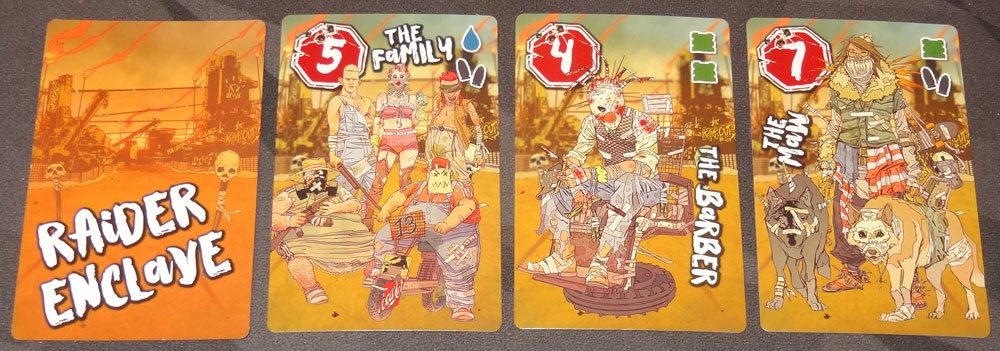
Note that you can only pillage one time per round—if you combat, your marker stays in Combat and you can attempt to Plunder again later in the same round. But if you have a marker in Plunder, you may not voluntarily enter combat.
Purchase Cargo
If you end your turn on a location that has a supply token, you may buy any number of that cargo for the price indicated, and then discard that token and draw a new supply token. Cargo must be placed into storage spaces on your truck; food and water go in general storage, and weapons go in weapons storage. If you don’t have room for something, you’ll have to discard it back to the supply.
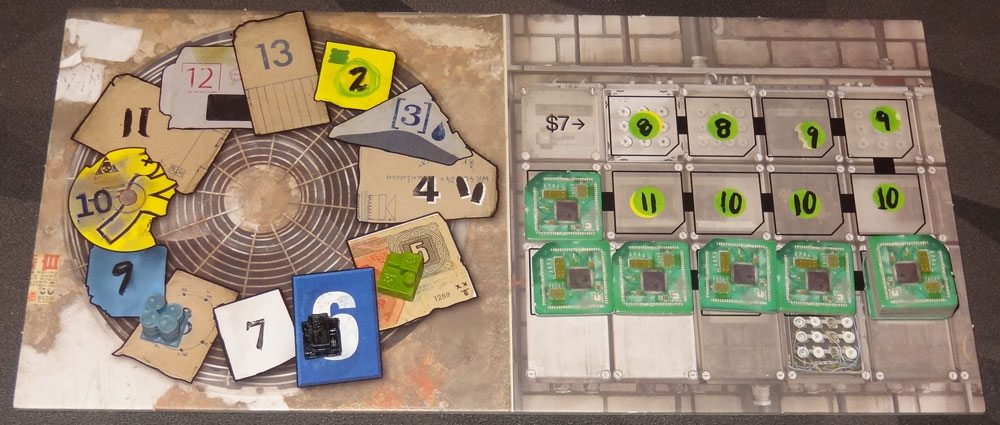
Deliver Cargo
If you’re at a location with a demand token, you may sell any number of the desired goods, with the price per good shown at the current market value. If the demand token has two goods on it, you must sell at least one of each, but you may sell any number total. After selling the good, replace the demand token—this may change the market price for the next sale. Then, place your “not welcome” standee in your current location. Because you drive a hard bargain, that town won’t buy from you again until you’ve sold somewhere else.
Activate an Outpost
Many of the outposts have additional actions printed on them. If so, you may use an Outpost action to do that action. Actions include:
- Purchase truck mods from the Mod Shop
- Purchase temporary mods from the Temp Mod Shop
- Take $3 from the Coffers
- Repair your truck for $3
- Buy a trailer (4 extra spaces) for $8
- Purchase artifacts from the Market Board (prices increase as artifacts are purchased)
- Draw faction job cards
- Hire an ally
There are a few other actions on the locations, but you get the idea.
Bonus Action
There are some faction jobs or contracts that require you to take the Bonus action—basically you need to arrive at that location, and then on your next turn you can do the Bonus action there if you don’t move away.
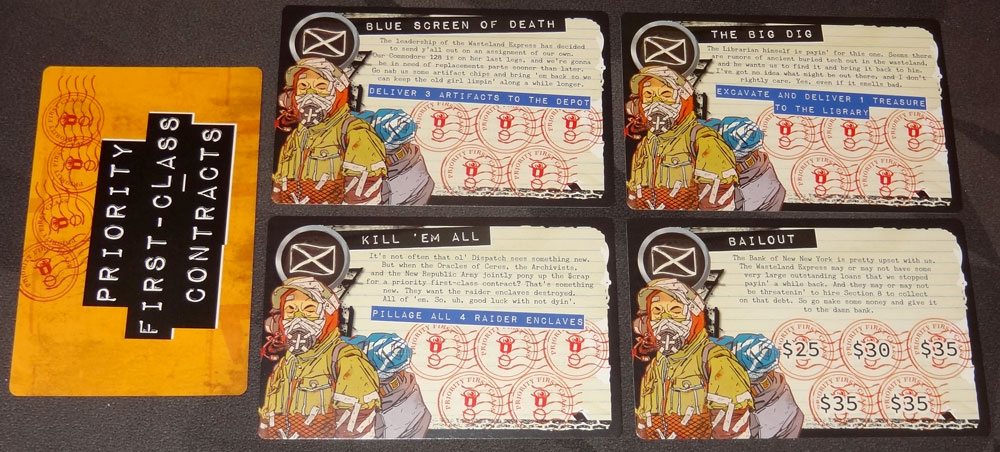
Priority First-Class Contracts
There are always three public priority first-class contracts on the table, and there are others in the faction job decks which are kept secret until you complete them. The contracts are marked with a small red postmark symbol. When you complete a contract, you place one of your standees on the circle. If you get all three of your contracts finished, you win the game!

There are a range of different contracts. “Blue Screen of Death” requires you to deliver 3 artifacts to the Depot—it’ll cost you a pile of money, plus you have to have storage space for the artifacts because you have to deliver all three at one time. You may be tasked with digging for buried treasure, pillage all four raider enclaves, or deliver a nuke across the wasteland. The Vision Quest contract will send you on a three-part journey across the desert.
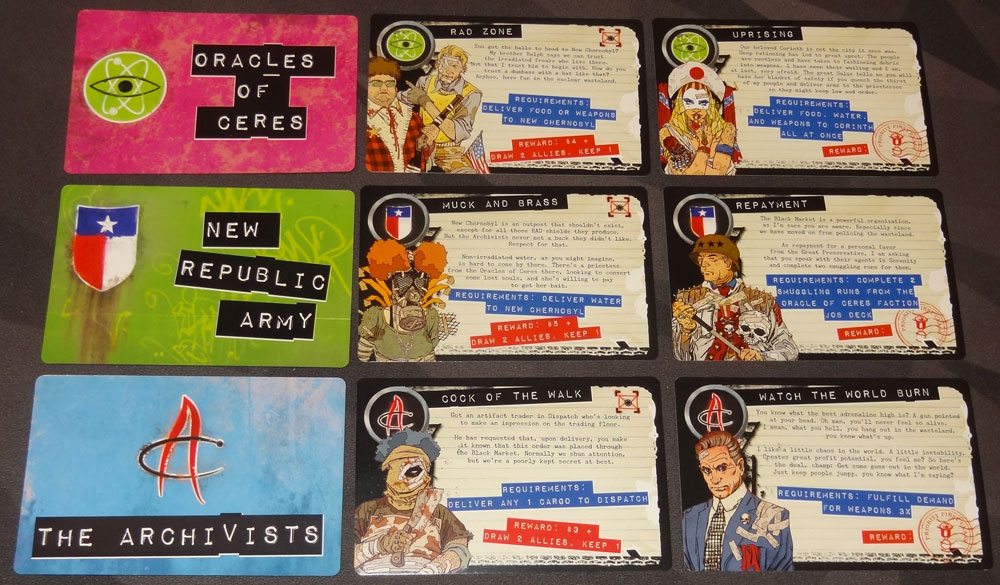
Faction Jobs
You start with one faction job, and you can acquire more at specific outposts. Each one has some sort of objective and a reward. You might be asked to deliver cargo to a particular location, or successfully attack a particular raider, and so on. Rewards may include scrap, allies, truck mods, or even the completion of a priority first-class contract.
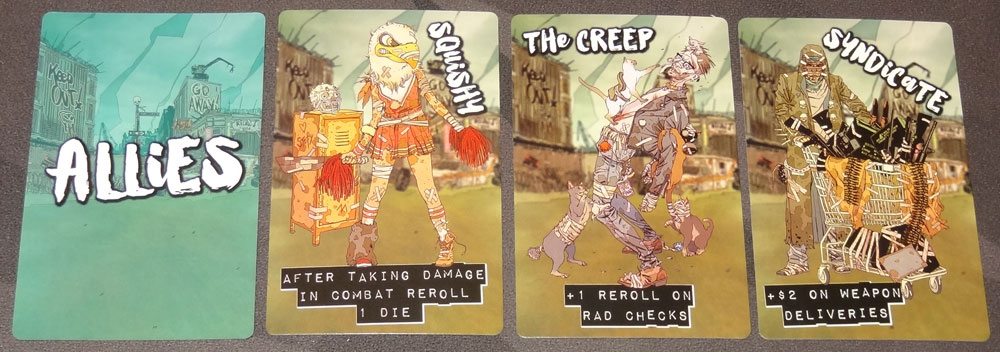
Allies
Allies can give you special effects—rolling more dice in combat, earning more money for deliveries, getting discounts at the Mod Shop, and more. You can carry one ally for free, but if you want more than one, you’ll need to invest in sleeper cab mods for your truck.
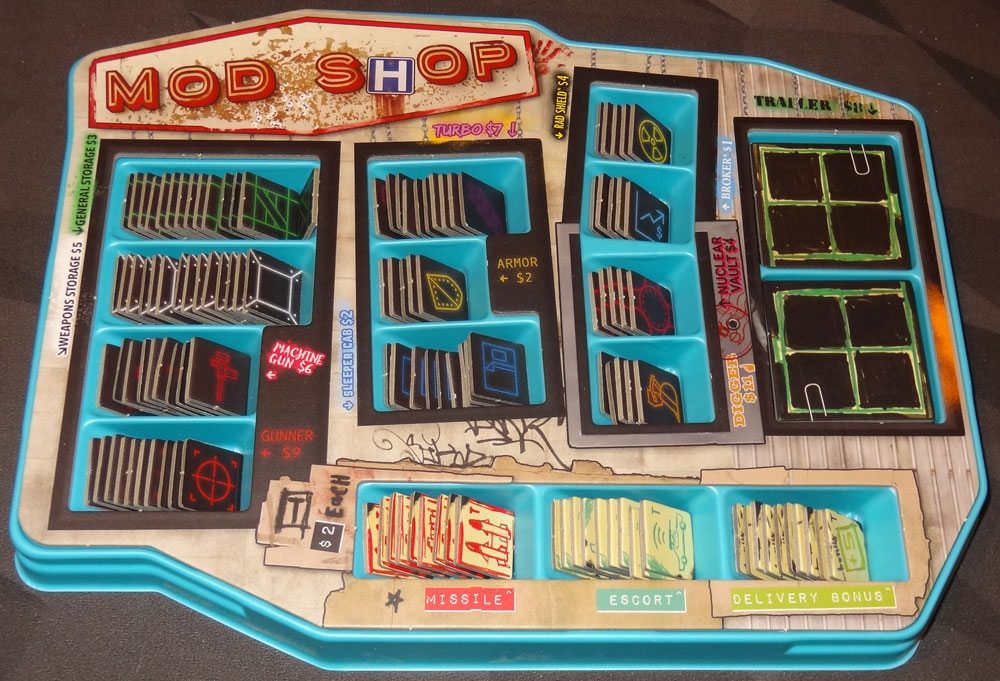
Truck Mods
Your player board shows you a diagram of your truck: there’s one space at the top for armor, and six more spaces below that. Each trailer mod gives you four more spaces (and you can have up to two trailers). When you buy a mod, you just put it into any of the spaces available (except for armor, which goes in the top slot). You can always dump mods you no longer want, but you don’t get anything for them. If you ever take damage, you place the damage token on any space in your truck (including an empty one)—that space can no longer be used until you get rid of the damage. So if you cover up a cargo space, you lose the cargo in it and can’t carry anything there.
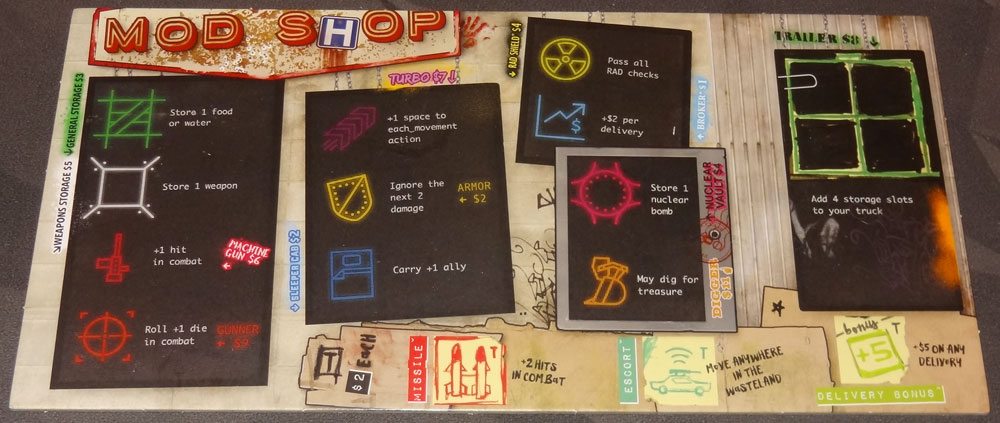
Here are the different mods:
- Armor: Absorbs 2 damage, and then is discarded
- Broker: Gives a $2 bonus each time you make a delivery
- General Storage: Holds food or water
- Weapons Storage: Holds weapons
- Digger: Dig for buried treasure (only with The Big Dig contract)
- Gunner: Roll an extra die in combat
- Machine Gun: Add an extra hit in combat
- Nuclear Vault: Carry a nuke (only with the Questionable Decisions contract)
- RAD Shield: Drive through irradiated zones without taking damage
- Sleeper Cab: Carry an additional ally
- Turbo: Move 1 additional space during movement actions.
There are also temp mods, which can only be used one time and then are discarded:
- Delivery Bonus: Earn an extra $5 on a delivery
- Escort: Move anywhere on the board for a free action
- Missile: Discard before rolling combat dice to add 2 hits

Gameplay Variants
The rulebook lists several variants, like one in which your delivery payout is affected by a die roll, or one where you can attack other players and not just the raider trucks.
There is also a campaign mode, which consists of 8 scenarios, in case you want to play out the story that’s told in the introduction of the rulebook. You play the scenarios in order, and each one has a bit of story and then some special setup rules. A few just tell you which three priority first-class contracts to use, but some also have specific terrain and outpost setups, along with some other special rules.
Wasteland Express Delivery Service Gameplay Video
If you’d like to see a play-through (with some discussion and analysis at the end), here’s a video! Steve and Tiffany Caires live stream games every week, and I joined them for this one:
Why You Should Play Wasteland Express Delivery Service
First, let me tell you a little bit more about the names on that box. Matt Riddle and Ben Pinchback have designed several games together, starting with Fleet back in 2012; Eggs & Empires was my Game of the Year back in 2014. I haven’t played every game they’ve published, but I’ve enjoyed several of them, and I always take notice when I see their names on a box. Jonathan Gilmour is probably best known for Dead of Winter, though he’s had several notable games since then as well.
One of the notable things about Dead of Winter was the story-based aspect. You weren’t just playing a zombie game (with a potential hidden traitor)—you had little stories that might trigger based on the active player’s actions. Instead of getting an abstract choice like “do you want another survivor or some gear?” you get a dilemma: “Here’s this helicopter pilot, Sophie Robinson, and she needs your help to survive. Are you going to help her back to the compound, or are you going to take her stuff and leave her to die?” Sure, the game effect is the same, but the second version gives your choice a bigger emotional impact.
Wasteland Express doesn’t have quite that level of storytelling within the game—you’ll get a bigger chunk of the story if you play through the campaign. But you do get little bits and pieces by reading the flavor text on the contracts and jobs and events. For instance, it’s telling that the contract to steal a nuke from one raider enclave and deliver it to another raider enclave on the other edge of the wasteland is called “Questionable Decisions” and maybe that will make you think twice about attempting it. If you like post-apocalyptic settings, you’ll feel right at home in the wasteland, from the weaponized vehicles to the wacky characters to the desolate landscape. (And as with other post-apocalyptic driving stories, nobody asks where all that fuel is coming from.)

The gameplay is a mix of pick-up-and-delivery and battles. When I spoke to Riddle and Pinchback at Gen Con this year, they mentioned that something they tried to build into the game was that you get to pick a focus if you want. If you focus on the economics, you can drive around, avoid fighting, and just make money by paying attention to the supply and demand. On the other hand, if you like rolling dice and risky behavior, you can go after the raider trucks and enclaves and shoot stuff up.
In practice, it’s not always quite so easy to separate these two pieces of the game. Depending on the contracts and faction jobs available, you might be tasked with attacking raiders, or delivering particular goods to a location. Even if you just like shooting at things, it’s a lot easier to do if you have more guns or gunners, and for those you’re gonna need some money … which typically means making deliveries. You definitely can lean toward one or the other, though: you can buy a trailer just to soak up damage as you drive past raider trucks, or you can stock up on mods and allies that help you fight so you can easily blast through anyone.
Add to that the fact that you can only pillage once and purchase once per round. If you’re wanting to pick up a lot of cargo (and you’ll need to have the storage space for it), there’s only so much you can pick up every 5 turns. So it certainly helps to be able to drive and shoot, because you’ll be able to get more cargo that way. Pillaging raiders is a great way to get cargo without paying money for it, but of course you’re best at pillaging if you’ve already spent some money on some fighting upgrades.
I like the way that the market board works, that the price you get for delivering cargo is determined by how many places want to buy it. It’s not a true supply-and-demand curve, since supply is totally independent, but it does mean you can play with and try to predict the market a little bit. Sometimes you want to race to sell when the price is good, before another driver can get there. Sometimes you hang onto your goods, hoping that demand will go up before you make your delivery. Just don’t forget to update the market board every time a delivery is made!
The “momentum” mechanic is also a nice touch, though it can be easy to forget to slide the gears around on your player board. You can usually move and take an action in a same turn (except for that Bonus action), but I like that you can forego an action to stay on the road, and pick up momentum. If you do that for three turns, you can get up to 12 spaces away. Buy yourself a Turbo mod, and you can move just about anywhere you want. Bandit, the guy who drives a muscle car with a trailer instead of a truck, gets a bonus on his first movement: his top speed isn’t better, but he accelerates more quickly.
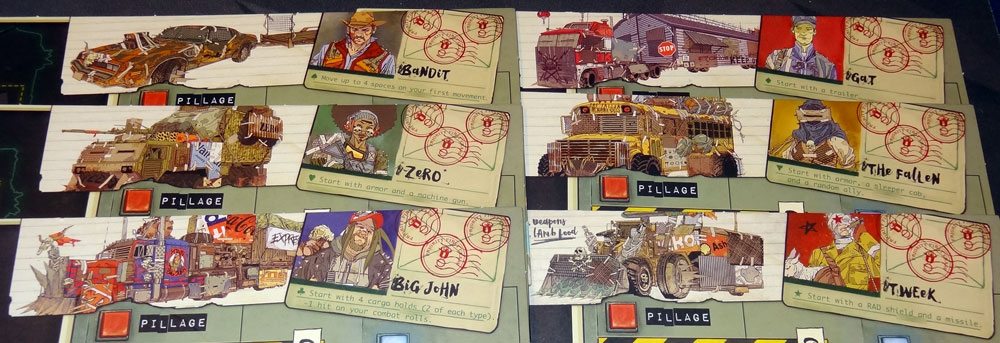
When you choose a character, you might pick based on the backstory: Tweek is a former raider who now has a pet lamb, and just cares about getting enough food to feed it. Or you might like the look of a particular character. You might pick The Fallen just because you like the idea of driving around in an old yellow school bus. Or you may pick one based on how its special ability lines up with your play style: Big John has extra cargo spaces, but is worse at combat; on the other hand, Zero is kitted out for combat with an armor and a machine gun. Using your character’s strength is key.
Despite being an enormous game with a lot of moving parts, I felt that the gameplay itself is not that complex. It takes a little getting used to moving the action markers around; sometimes it’s easy to move one to movement and then another to actions, and then you don’t have enough available. But once you get used to that, they do help keep track of your actions and it’s easy to see what’s still available. The “not welcome” standees are another rule that can be easily forgotten—we often made deliveries, and then remembered to move the “not welcome” standee a few turns later. Figuring out how to string together a series of simple moves into a winning strategy, though—that’s the part that isn’t always so simple.
It can be a little frustrating at times, being limited in the number of actions you can do per round. For instance, you can only make one purchase per round. Maybe you notice a $1-per-water supply pop up when water is in high demand, and so you make a plan to drive all the way over there, maybe even picking up an extra storage mod along the way. And then when you get there … you realize you’ve already made a purchase this round, so somebody else can sweep in and buy it (and you’ve wasted three turns). I think the frustration comes more from how easy it is to forget that you don’t have that action anymore, and maybe familiarity with the game will lessen that.
Me, I like the logistics game. Finding a good path to follow that lets me get cargo, deliver it, and then spend the money I just made, in the fewest number of moves—to me, that’s extremely satisfying when it works out. If it works out. In one game, I had two contracts I could fulfill that were very near each other, but each one required a Bonus action, which meant I had to do them over two separate rounds. Ideally, I could reach the first location in time to use my Bonus action at the end of one round, and then move to the other location and do the Bonus action soon after. Unfortunately, I was off by one space, and had to use my last move of the round to get to the location. Then I spent my first action the next round on a Bonus, which meant I had to cool my heels for the rest of the round … during which time another player snuck ahead of me and fulfilled his contracts.
Overall, I think Wasteland Express Delivery Service delivers what it promises: a crazy game about driving armored vehicles around in a hostile wasteland, getting shot at by masked raiders. If you don’t like that theme, it’s probably not for you. If you do like the theme, then there’s plenty of it in this box. The components are top-notch (and those GameTrayz! Woo!), and there are enough missions and factions to mix it up from play to play. So pick your rig, fill up the tank, and hit the road!
Click here to see all our tabletop game reviews.
Disclosure: GeekDad received a copy of this game for review purposes.

